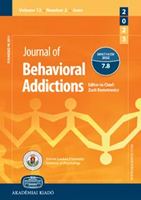How much gaming is too much? An analysis based on psychological distress
How much gaming is too much? An analysis based on psychological distress
Author(s): Dana Katz, Zsolt Horváth, Halley M. Pontes, Patrik Koncz, Zsolt Demetrovics, Orsolya KirálySubject(s): Clinical psychology, Behaviorism, Substance abuse and addiction
Published by: Akadémiai Kiadó
Keywords: gaming disorder; gaming time; psychological distress; latent profile analysis;
Summary/Abstract: Background: While there are calls to restrict the time spent on gaming because it is seen as problematic and potentially leading to gaming disorder (GD), there is conflicting evidence about this issue. We explored the association between the average weekly time spent gaming and reported GD symptoms. Additionally, Latent Profile Analysis was employed to investigate how time spent gaming relates to variables representing psychological distress (PD), such as satisfaction with life, symptoms of depression, and perceived stress. Methods: Data were collected using surveys with a large sample of highly engaged gamers (N 5 14,740; Mage 5 24.14 years, SDage 5 7.0, 89.3% males). Results: We observed a positive, close to linear association between time spent gaming and GD symptoms. Groups at risk of GD played for about 42 h (SD 5 19) on average, according to the American Psychiatric Association and World Health Organization frameworks. Furthermore, we identified four profiles representing varying levels of PD. Gamers reporting very high levels of PD (4.2% of the sample) played for 33 h per week on average. Remarkably, a substantial percentage of the sample (41.9%) showed no PD despite playing for 26 h per week. Conclusion: The association between gaming time and PD is complex as even prolonged time spent gaming can be unproblematic for many gamers.
Journal: Journal of Behavioral Addictions
- Issue Year: 13/2024
- Issue No: 3
- Page Range: 716-728
- Page Count: 13
- Language: English

